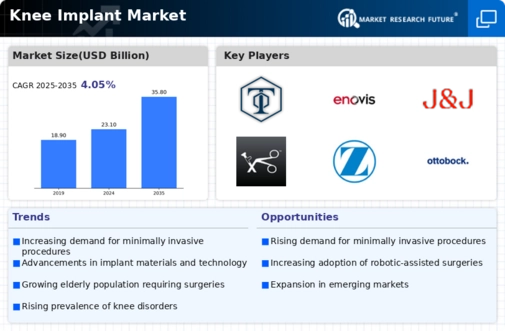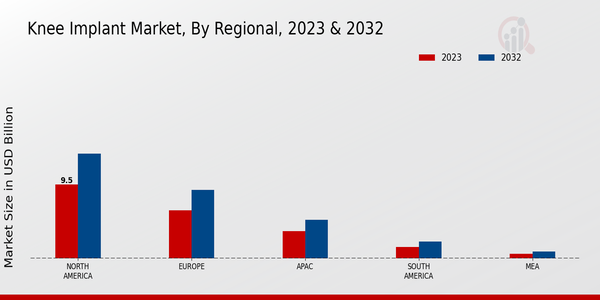Market Growth Projections
The Global Knee Implant Market Industry is poised for substantial growth, with projections indicating a market size of 23.1 USD Billion in 2024 and an anticipated increase to 35.8 USD Billion by 2035. This growth trajectory suggests a compound annual growth rate (CAGR) of 4.05% from 2025 to 2035. Such figures reflect the increasing demand for knee implants driven by various factors, including technological advancements, demographic shifts, and rising healthcare expenditures. The market's expansion is indicative of the evolving landscape of orthopedic care and the ongoing need for innovative solutions in knee health.
Growing Geriatric Population
The global demographic shift towards an aging population is a critical driver for the Global Knee Implant Market Industry. As individuals age, they are more susceptible to degenerative joint diseases, leading to a higher demand for knee replacement surgeries. By 2024, the market is anticipated to reach 23.1 USD Billion, reflecting this demographic trend. Countries with significant elderly populations, such as Japan and Italy, are witnessing a surge in knee implant procedures. This growing geriatric demographic underscores the necessity for healthcare providers to adapt and expand their offerings in knee implant solutions.
Increased Healthcare Expenditure
Rising healthcare expenditure across various nations plays a pivotal role in shaping the Global Knee Implant Market Industry. Governments and private sectors are investing more in healthcare infrastructure, which includes orthopedic surgeries and knee implants. This trend is particularly evident in emerging economies where economic growth leads to improved healthcare access. As a result, the market is projected to grow at a CAGR of 4.05% from 2025 to 2035, indicating a robust investment in knee implant technologies and services. Enhanced funding allows for better surgical facilities and advanced implant options, ultimately benefiting patients.
Rising Prevalence of Osteoarthritis
The increasing incidence of osteoarthritis globally drives demand within the Global Knee Implant Market Industry. As populations age, the prevalence of knee-related disorders rises, necessitating surgical interventions. For instance, it is estimated that by 2024, the market will reach 23.1 USD Billion, reflecting the urgent need for effective treatment options. This trend is particularly pronounced in developed nations where lifestyle factors contribute to joint degeneration. Consequently, healthcare systems are compelled to invest in knee implants to improve patient outcomes, thereby propelling market growth.
Awareness and Education on Joint Health
Increasing awareness regarding joint health and the benefits of knee implants significantly influences the Global Knee Implant Market Industry. Educational campaigns by healthcare organizations aim to inform the public about the advantages of timely interventions for knee disorders. As awareness grows, more individuals seek medical advice and treatment options, leading to an uptick in knee replacement surgeries. This trend is expected to contribute to the market's expansion, with projections indicating a rise to 35.8 USD Billion by 2035. Enhanced public knowledge fosters a proactive approach to joint health, driving demand for knee implants.
Technological Advancements in Implant Design
Innovations in knee implant technology significantly enhance the performance and longevity of devices, thereby influencing the Global Knee Implant Market Industry. Recent advancements include the development of personalized implants and minimally invasive surgical techniques, which improve recovery times and patient satisfaction. For example, the introduction of 3D printing technology allows for customized implants tailored to individual anatomies. Such innovations not only increase the efficacy of knee surgeries but also attract more patients seeking advanced treatment options, contributing to the projected market growth to 35.8 USD Billion by 2035.










